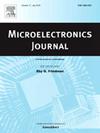A simple interface circuit for edge inference kernels based on SC-LNO memristor crossbar
IF 1.9
3区 工程技术
Q3 ENGINEERING, ELECTRICAL & ELECTRONIC
引用次数: 0
Abstract
Edge inference chips based on non-volatile memory hold promise in mitigating the bottleneck attributed to substantial data movement in artificial intelligence (AI) applications. Particularly, the efficient acceleration of numerous vector matrix multiply-accumulate (VMM) operations can be achieved through the collaboration of memristor crossbars and associated peripheral circuits. These efficient operations utilize the synaptic plasticity, high integration density, and inherent parallel execution capabilities of memristor crossbars. However, analog memristive devices often exhibit non-idealities such as readout nonlinearity, necessitating compatible peripheral interface circuits to ensure precision and stability in readout. In this work, a simple interface application-specified integrated circuit (ASIC) tailored to support non-ideal single-crystal (SC-LNO) memristor crossbars is proposed, facilitating the efficient realization of VMM operations. The transmit (TX) and receive (RX) components of the interface circuit are respectively responsible for stimulating and reading the outputs of the memristor crossbar. A common-mode voltage strategy is employed to avoid the I–V nonlinearity and negative voltage sensitivity inherent in memristors. The trans-impedance readout front end within the RX module ensures signal stability in the presence of large input parasitic capacitance. As a proof of concept, a 180-nm prototype ASIC is tested in conjunction with a resistor array featuring parallel parasitic capacitance, demonstrating its linearly stable readout capability. The entire interface circuit consumes a mere 2 mW, with the ASIC’s active area measuring 0.086 mm.
求助全文
约1分钟内获得全文
求助全文
来源期刊

Microelectronics Journal
工程技术-工程:电子与电气
CiteScore
4.00
自引率
27.30%
发文量
222
审稿时长
43 days
期刊介绍:
Published since 1969, the Microelectronics Journal is an international forum for the dissemination of research and applications of microelectronic systems, circuits, and emerging technologies. Papers published in the Microelectronics Journal have undergone peer review to ensure originality, relevance, and timeliness. The journal thus provides a worldwide, regular, and comprehensive update on microelectronic circuits and systems.
The Microelectronics Journal invites papers describing significant research and applications in all of the areas listed below. Comprehensive review/survey papers covering recent developments will also be considered. The Microelectronics Journal covers circuits and systems. This topic includes but is not limited to: Analog, digital, mixed, and RF circuits and related design methodologies; Logic, architectural, and system level synthesis; Testing, design for testability, built-in self-test; Area, power, and thermal analysis and design; Mixed-domain simulation and design; Embedded systems; Non-von Neumann computing and related technologies and circuits; Design and test of high complexity systems integration; SoC, NoC, SIP, and NIP design and test; 3-D integration design and analysis; Emerging device technologies and circuits, such as FinFETs, SETs, spintronics, SFQ, MTJ, etc.
Application aspects such as signal and image processing including circuits for cryptography, sensors, and actuators including sensor networks, reliability and quality issues, and economic models are also welcome.
 求助内容:
求助内容: 应助结果提醒方式:
应助结果提醒方式:


